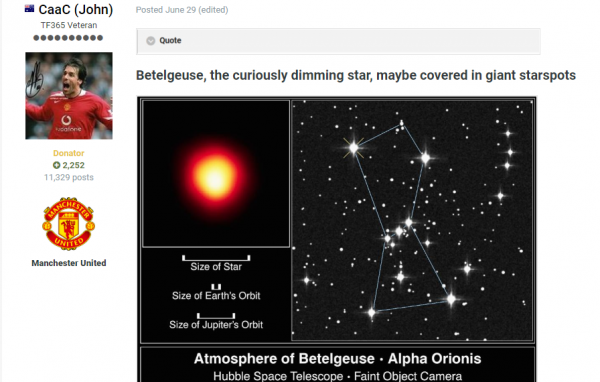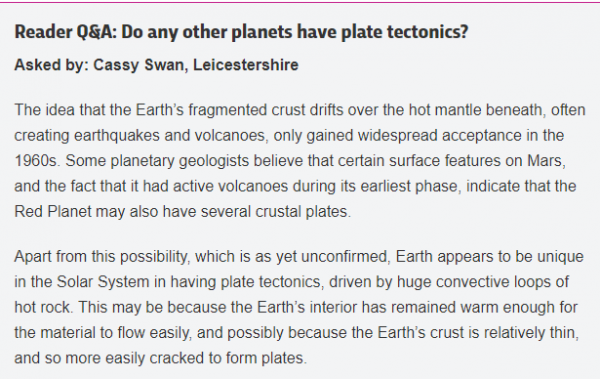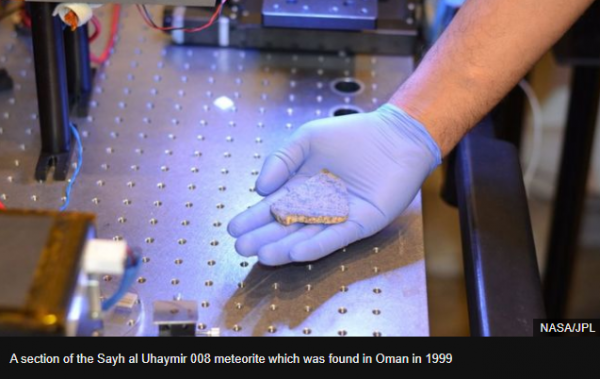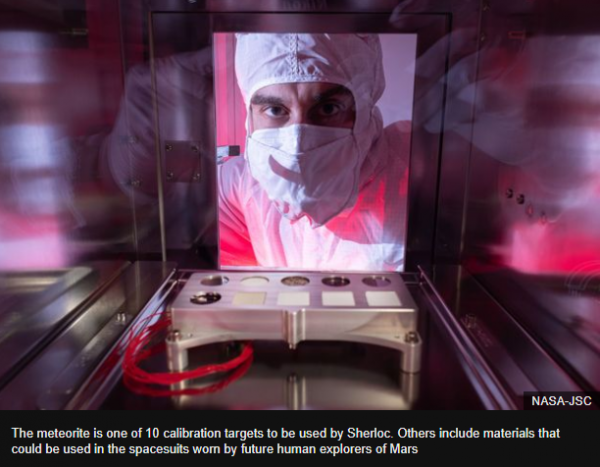-
Posts
20,851 -
Joined
-
Last visited
-
Days Won
49
Everything posted by CaaC (John)
-
The worse heat for me was in Australia, I hated it and with all the flies and mossies buzzing around your face and arm's was a nightmare, this was back in the '60s & early '70s so there was none of these wonder sprays and creams they have nowadays, my old man was used to the heat being in the navy and I can remember once when it was around 40c in Melbourne and I complained of the heat and he said "watch this son...", he took an egg and cracked it on the pavement and the fucking egg started to fry!!!!
-
Warm as fuck all day, I hate the heat and it's hit 24c here and I was sweating my bollocks off and the wife had the cheek to say a wee while ago "It's getting a bit chilly now...", give me snow any day and they reckon there is a bit of rain, thunder & lightening later, I will have some of that.
-
Fractured, Netflix (2019) It started off a bit slow, then got better but the ending was shite and that knocked down the rating for me, 5/10.
-

Manchester United Discussion
CaaC (John) replied to a topic in Premier League - English Football Forum
-
Jason Statham in Parker, an oldie and have seen it ages ago but I like Statham movies and this is an 8.5/10 for me.
-
________________________________________________________________________________________________ Is the Betelgeuse star about to explode? The supergiant star has been behaving strangely in recent months. Could it be about to go supernova? In the constellation of Orion, something strange is afoot. In October 2019, the red star Betelgeuse – which marks Orion’s right shoulder (or left as we look at it) – began to get unusually dim. During January and February 2020, it reached a record low – around 40 per cent of its usual brightness. We know that Betelgeuse is a mature star and that it will one day explode in a supernova. But this dimming has led to speculation that a supernova could be imminent. Might this be a moment of calm before the star expires in a cosmic death-blast? The dimming of Betelgeuse (the name of the star has its origins in Arabic, and there’s no consensus on how to pronounce the Westernised version, but ‘Beet-el-joos’ is one of the more common variants – as popularised in the 1988 film Beetlejuice) is not completely unexpected. It’s what’s known as a ‘variable’ star, whose brightness fluctuates. In Betelgeuse’s case, this fluctuation follows a roughly 420-day cycle, and – in line with this cycle – there are now signs that the star is slowly brightening again. “But even if Betelgeuse perks up, it still leaves us with questions,” says Dr Emily Levesque, an astronomer who studies the physics of massive stars at the University of Washington. “It’s got so much dimmer than normal – way more than we would expect.” Betelgeuse is a red supergiant – the largest class of stars in the Universe in terms of volume. It has a radius of around 600 million kilometres: if you plonked Betelgeuse in the middle of the Solar System – where the Sun is – it would reach almost to Jupiter, engulfing Mercury, Venus, Earth and Mars. Red supergiants form when a massive star runs out of hydrogen in its core and can no longer convert hydrogen into helium via nuclear fusion. At this point, the core begins to contract, which raises the star’s internal temperature and ignites a shell of hydrogen fusion around the core, causing the star’s outer layers to expand and cool. The temperature inside Betelgeuse’s core is so hot that the helium there has begun to fuse into carbon. Once the helium is exhausted, the core will rapidly work its way through heavier elements, all the way to iron. At this point, the star can generate no more energy, so the core will collapse. The outer layers will follow, bouncing off the core and exploding in a supernova. Why is Betelgeuse dimming? So could the dimming be a sign of an imminent supernova? Levesque admits that we still know very little about what a star will do in the final days and weeks before it explodes. But she says that the best guess for when Betelgeuse will die, according to where scientists think it is in its life cycle, is in 100,000 years. “A supernova tomorrow is not flat out impossible,” she says, “But it’s unlikely.” So what’s responsible for the recent dimming? Betelgeuse’s usual 420-day pulsation cycle – which is caused by variations in the star’s size – cannot alone account for the dimming, says Levesque, so there’s probably at least one other mechanism going on. One possibility is that the star is being obscured, making it appear dimmer. “We know that stars like Betelgeuse periodically shed mass from their surface, which condenses into dust around the star,” she says. “This would effectively block our view.” “We also know that red supergiants have big convective zones on their surfaces,” says adds. Hot gas from deep inside the star rises to the surface, where it cools and sinks again. Changes in this circulation could be altering the star’s surface temperature, and hence its brightness – another possible explanation for what’s going on. Whatever Betelgeuse is currently doing, there’s no question that it’ll explode at some point. “It’ll be absolutely unmissable,” says Levesque. “The star is only a few hundred light-years away, so the light from the supernova will be incredibly bright – comparable to Venus or the Moon.” We’ll see it in the sky as a pinprick of light – even during daytime – and our telescopes will be able to see the nebulous ‘supernova remnant’ in all its glory. But don’t worry: although Betelgeuse is relatively close to us, it’s still far enough away that there’ll be no danger from the supernova’s high-energy radiation. As for Betelgeuse, it’ll most likely become an ultra-dense neutron star. In the meantime, astronomers are getting all the data they can. “As we study more of these red supergiants, we should get better at pinpointing what stage of their evolution they’re in, and when they’re likely to die,” says Levesque. “We know that stars like this make most of the elements in the Universe – both when they’re alive and when they die as supernovae. Understanding how this works will tell us more about how the make-up of the Universe evolved. These stars seeded the chemistry that made life possible.” Science Focus
- 1,657 replies
-
- space exploration
- astronomy
-
(and 1 more)
Tagged with:
-
NE Scotland, Orkney & Shetland Kelp found off Scotland dates back 16,000 years to last ice age Scientists have discovered kelp off the coast of Scotland, Ireland and France that has survived since the last ice age, around 16,000 years ago. Experts from Heriot-Watt University's Orkney campus analysed the genetic composition of oarweed from 14 areas across the northern Atlantic ocean. The team found three distinct genetic clusters. It is hoped the discovery could help show how marine plant life survives extreme changes in climate. Dr Andrew Want collected samples from Kirkwall Bay, near his home. The marine ecologist said the "refugee populations" managed to hang on and survive "amid dramatic changes". 'Critical role' Dr Want, who is based at Heriot-Watt's International Centre for Island Technology in Orkney, said: "Oarweed in Scotland and Ireland is more closely related to populations in the high Arctic than to the Brittany cluster. "As the ice sheets retreated from northern European shorelines at the end of the most recent ice age, oarweed distribution followed and recolonised the higher latitudes of the Atlantic. "Kelp plays a critical role in the Atlantic so it is important to understand what affects its distribution and survival over time and how sensitive it is to change." The research team, which included academics based in Portugal and France, found one distinct genetic cluster along the eastern seaboard of Canada and the US. Another was discovered in central and northern Europe and a third compact population around Brittany. 'Rapidly-changing temperatures' Dr Want said the "Brittany population" is once again close to the other populations but has managed to remain distinct. He added: "Worryingly, this unique Brittany gene pool is projected to disappear under greenhouse gas emission scenarios. "This provides further evidence of the loss of biodiversity expected with rapidly changing marine temperatures." The team's findings have been published in the European Journal of Phycology. Dr Joao Neiva, from Algarve's Centre of Marine Sciences, said: "Our study shows how marine organisms adjust to shifting climates by migrating polewards and even across the Atlantic when conditions are favourable. "These migrations provide a mechanism by which marine life buffers the effects of global climatic shifts, and how they can compensate for predictable contractions at warmer limits as the modern climatic crisis unfolds. "While the species may not be threatened at global scales, range contractions can have very negative impacts if vanishing ranges are composed of unique and diverse populations. "This is certainly the case off the coast of Brittany." https://www.bbc.co.uk/news/uk-scotland-north-east-orkney-shetland-53558308
-
July 27, 2020 NASA’s Next Mars Rover to Test Tech Useful for Human Missions Robot explorers are helping pave the way for human exploration of the Red Planet. NASA’s newest Mars rover, Perseverance, is equipped with technology to teach us more about the environment and demonstrate what’s needed to support future crewed missions. “Perseverance paves the way for new science and technological discoveries,” said Jim Reuter, the associate administrator for NASA’s Space Technology Mission Directorate (STMD). “The knowledge and capabilities we gain from this mission will help prepare us for human missions on Mars as early as the 2030s. Technology will drive that exploration.” Capabilities needed by future pioneers will get their first test on the Red Planet in 2021. Hardware to ensure a precise landing, a mobile weather station and a brand-new method of producing oxygen from carbon dioxide is packed with all of the science gear. FULL REPORT
-
These sightings of engendered tigers in western Thailand are rekindling hope that the animals are returning to the country's forests after being poached near extinction. Source: CNN
-
Bringing Mars back to Earth The US and European space agencies are about to begin an audacious effort to bring samples of Martian rock and soil back to Earth. It will involve two robotic rovers to collect the best specimens, and an elaborate delivery system to get this material home. Scientists hope to then learn more about whether life has ever existed on the Red Planet by studying the samples using techniques that are only available in Earth laboratories. A new rover built by Nasa and named Perseverance will land on Mars in February 2021 using the "sky crane" method. A giant parachute and rocket motors will slow the mission's descent before the rover is lowered to the surface using cables. Perseverance - a six-wheeled robotic machine with 23 cameras and a drill - will seek signs of ancient life in a large crater Jezero. It will collect rock and soil samples that look like they may have been altered by contact with microorganisms. The rover will store its samples in metal canisters - but leave them behind on the Martian surface to continue its mission. Perseverance's plutonium-based power supply could keep the rover trundling around Mars for 10 years or more. Later this decade - after 2026 - a second, smaller rover, to be built by the European Space Agency (Esa), will arrive on Mars. This "fetch rover" will travel across the surface picking up the sample canisters left behind by Perseverance. The canisters will be loaded into a protective container and placed into a small rocket - the Mars Ascent Vehicle or MAV. This will blast into the sky, placing the container into orbit around Mars. The sample container will be met in orbit and caught by a European satellite. This "return orbiter" will act like a cargo ship, bringing the precious rock and soil specimens back to Earth. We don't expect the satellite to arrive home until at least 2031, by which time the sample container will have been packaged in a heavily protected capsule, to be sent into Earth's atmosphere to land in North America. Scientists will then study the rocks and soil using advanced techniques, including some that have yet to be invented because there should be enough material to investigate for decades ahead. The samples will shed light on Mars' history and whether it has ever supported microbial lifeforms. https://www.bbc.co.uk/news/science-environment-53553623
-

Premier League Confirmed Transfers
CaaC (John) replied to CaaC (John)'s topic in Premier League - English Football Forum
See all the moves in the summer transfer window at the Premier League clubs ahead of the 2020/21 season The summer 2020 transfer window started on 27 July and is open for 10 weeks, ending on 5 October. A domestic-only window, during which Premier League clubs can only trade with those in the EFL, will run from 5 October to 17:00 BST on 16 October. This transfer window is subject to the approval of FIFA. Clubs were granted a one-day window to register new players on 1 July. Please note the deals, loan or permanent, announced by Premier League clubs below may still be subject to international clearance and/or administrative details before they can be confirmed. IN - OUT Summer Transfer Window Edit: Last Updated - 27 July 2020 30 July 2020 -
Congratulations @Fairy In Boots in your team staying up by the skin of their teeth, how do you think you will fare next season or will it be the same as this year?
-
Celtic manager Neil Lennon is targeting a move for West Ham and Switzerland striker Albian Ajeti, 23. (Daily Record)
-
Venus has at least 37 recently-active volcanoes It was previously thought that the planet had cooled down too much to show volcanic activity. Venus is home to at least 37 recently-active volcanic structures, a study by researchers at the University of Maryland and the Institute of Geophysics at ETH Zurich has found. It is the first evidence that the interior of the planet is still geologically active. Previous studies have found evidence of a warm interior and ring-like structures known as coronae, which form when plumes of hot material deep inside the planet rise through the mantle layer and crust in a manner similar to the way mantle plumes formed the volcanic Hawaiian Islands. However, it was thought that they were signs of the ancient activity and that the planet had cooled enough to slow down geological activity in the planet’s interior and harden the crust so much that any warm material from deep inside would not be able to puncture through. In the new study, the researchers created models of the thermal activity beneath the surface of Venus to create high-resolution, 3D simulations of coronae formation. They then used these to identify features that are present only in recently-active coronae and looked for similar structures on the surface of Venus. A 3D render showing two coronae observed on the surface of Venus © University of Maryland “This is the first time we are able to point to specific structures and say ‘Look, this is not an ancient volcano but one that is active today, dormant perhaps, but not dead,’” said Laurent Montési, a professor of geology at the University of Maryland. “This study significantly changes the view of Venus from a mostly inactive planet to one whose interior is still churning and can feed many active volcanoes.” A global map of Venus showing active coronae (red) and inactive coronae (white) © Anna Gülcher The active coronae on Venus are clustered together in a handful of locations, which suggests areas where the planet is most active. This may help identify target areas where geologic instruments should be placed on future missions to Venus, such as Europe’s EnVision that is scheduled to launch in 2032. Science Focus
- 1,657 replies
-
- 1
-

-
- space exploration
- astronomy
-
(and 1 more)
Tagged with:
-
Science & Environment What the heroin industry can teach us about solar power If you have ever doubted whether solar power can be a transformative technology, read on. This is a story about how it has proved its worth in the toughest environment possible. The market I'm talking about is perhaps the purest example of capitalism on the planet. There are no subsidies here. Nobody is thinking about climate change - or any other ethical consideration, for that matter. This is about small-scale entrepreneurs trying to make a profit. It is the story of how Afghan opium growers have switched to solar power, and significantly increased the world supply of heroin. Black Hawk over Helmand I was in a military helicopter thundering over the lush poppy fields of the Helmand valley in Afghanistan when I spotted the first solar panel. You've heard of Helmand. It is the most dangerous province in Afghanistan. Of the 454 British soldiers who died in the recent conflict in Afghanistan, all but five lost their lives in Helmand. The province is also at the heart of by far the most productive opium-growing region on the planet. FULL REPORT
-
Nasa Mars rover: Meteorite to head home to Red Planet A small chunk of Mars will be heading home when the US space agency launches its latest rover mission on Thursday. Nasa's Perseverance robot will carry with it a meteorite that originated on the Red Planet and which, until now, has been lodged in the collection of London's Natural History Museum (NHM). The rock's known properties will act as a calibration target to benchmark the workings of a rover instrument. It will give added confidence to any discoveries the robot might make. This will be particularly important if Perseverance stumbles across something that hints at the presence of past life on the planet - one of the mission's great quests. "This little rock's got quite a life story," explained Prof Caroline Smith, head of Earth sciences collections at the NHM and a member of the Perseverance science team. "It formed about 450 million years ago, got blasted off Mars by an asteroid or comet roughly 600,000-700,000 years ago, and then landed on Earth; we don't know precisely when but perhaps 1,000 years ago. And now it's going back to Mars," she told BBC News. Discovered in the deserts of Oman in 1999, the meteorite, known as Sayh al Uhaymir 008, or SaU 008, is a classic piece of basalt - very similar to the type of igneous rock you will find, for example, at Giant's Causeway in Northern Ireland. It contains lots of pyroxene, olivine and feldspar minerals. And it's this well-studied chemistry, together with the meteorite's textures, that make it so useful for Perseverance. The rock has been put in a housing, along with nine other types of material, on the front of the rover where it will be scanned from time to time by the Sherloc instrument. This is a tool that contains two imagers and two laser spectroscopes, which together will investigate the geology of the rover's landing site - a 40km-wide crater called Jezero. Satellite images suggest the bowl once held a lake, and scientists consider it to be one of the best places on Mars to try to find evidence of past microbial activity - if ever that took place. Sherloc will study the local rocks and soil, looking for signatures of ancient biology. What scientists don't want, however, is to have what they think is a "eureka moment" only to then realise Sherloc had developed some systematic error in its observations. "We'll look at the calibration target in the first 60-90 days and perhaps not again for six months because we think the instrument is really very stable," said Dr Luther Beegle, Sherlock's principal investigator from Nasa's Jet Propulsion Laboratory. "But if we start seeing interesting things on the surface of Mars that we can't explain in the spectra, then we'll look back to the calibration target to make sure that the instrument's working correctly. "I think the best we're going to be able to do from a scientific perspective is to identify what we would call a 'potential bio-signature'. "I don't think we'll ever be necessarily 100% sure because that's a hard measurement to make, which is why the sample-return aspect of Perseverance is so important." The rover will package its most interesting rock samples into small tubes that will be left on the surface of Mars for retrieval and return to Earth by later missions. Prof Smith is hopeful she'll get to work on this material, which could come back in the next 10-15 years. The NHM expert is on an international panel that will determine how best to handle the extra-terrestrial rocks. "I'm actually leading the curation focus group," she told BBC News. "By this time next year, we should have a really good plan for the sort of building we will need, the types of processes that will be happening in that building, and how we'll actually start curating the samples and making them available to scientists for study." Researchers will have a much better chance of confirming life on Mars if they can assess the evidence using all the analytical tools available in Earth laboratories, as opposed to just the small suite of instruments carried by a robot rover. Nasa's Perseverance rover is scheduled to lift off on a United Launch Alliance Atlas rocket from Cape Canaveral, Florida, during a two-hour window that begins at 07:50 local time (11:50 GMT; 12:50 BST). The slice of SaU 008 won't be the only Martian meteorite on board. The rover's SuperCam instrument will have its own piece of Mars rock, again to act as a calibration target. https://www.bbc.co.uk/news/science-environment-53491555
-
Happy Birthday, Phill, you are looking good and catching up on me... age-wise.
-
What, is that the name of the film?
-
-
Did you listen to the audio of the voice from 1899? it gave me the creeps. AUDIO
-
Rare yellow turtle discovered in India CNN - A farmer in eastern India has found a yellow turtle which experts say is the product of albinism. Basudev Mahapatra spotted the turtle while he was working in his fields in the village of Sujanpur, in Odisha's Balasore district, and decided to bring it home, forest official Susanta Nanda told CNN on Tuesday. Mahapatra found the turtle on Sunday and handed it over to forest officials, who called in conservation experts. Siddhartha Pati, executive director at the Association for Biodiversity Conservation, which works to protect wildlife and habitats, told CNN it was the first time he had seen this kind of turtle. The Indian flap shell turtle is commonly found in parts of South Asia. Pati explained that the creature's colour is due to albinism. "It is a congenital disorder and it is characterized by complete or partial absence of tyrosine pigment," he said. "Also, sometimes a mutation takes place in the gene sequence or there is a deficiency of tyrosine." The turtle has now been released into the wild in Balasore, added Pati. The turtle is known as the Indian flap shell turtle. This one was an adult -- believed to be between one and a half and two years old. "We find turtles and crabs regularly and we rescue them and release them into the water. But this is the first time in Odisha and second time in India that an albino turtle has been found," said Pati. The turtle is commonly found in Pakistan, Sri Lanka, India, Nepal, Bangladesh and Myanmar. It is omnivorous and its diet consists of frogs, snails and even some aquatic vegetation, he added. _______________________________________________________________________ In 2016, a rare albino green turtle -- newly hatched -- was spotted on an Australian beach. Volunteers from Coolum and North Shore Coast Care were "amazed" to see the tiny creature, which they named Little Alby, at Castaways Beach, on Queensland's Sunshine Coast. CNN
-
- 1,657 replies
-
- space exploration
- astronomy
-
(and 1 more)
Tagged with:






.thumb.png.6a48bcc4b3ecd45c97268044e4241e90.png)

.png.258f1e24aa1566c589c7ac7b0ada8f7e.png)










.png.11b743b32cd38b8433ad824b22fd7983.png)

